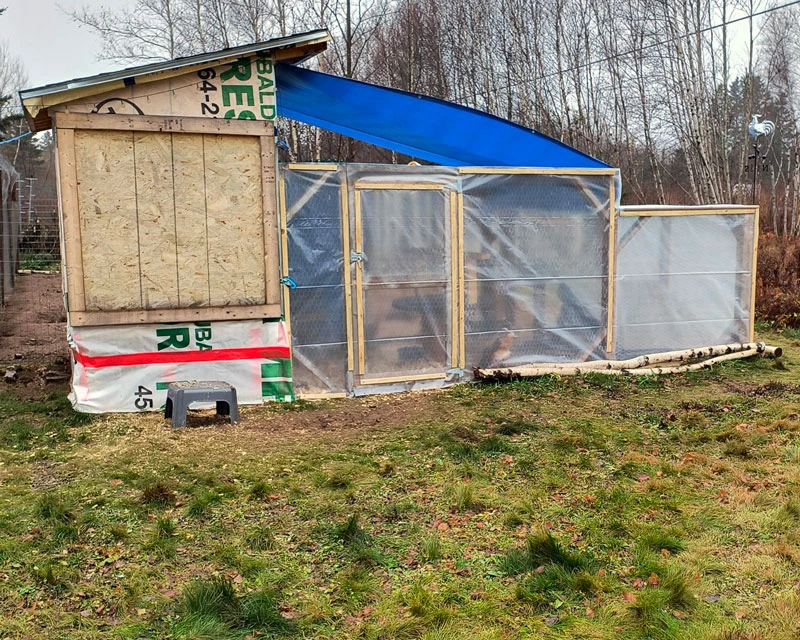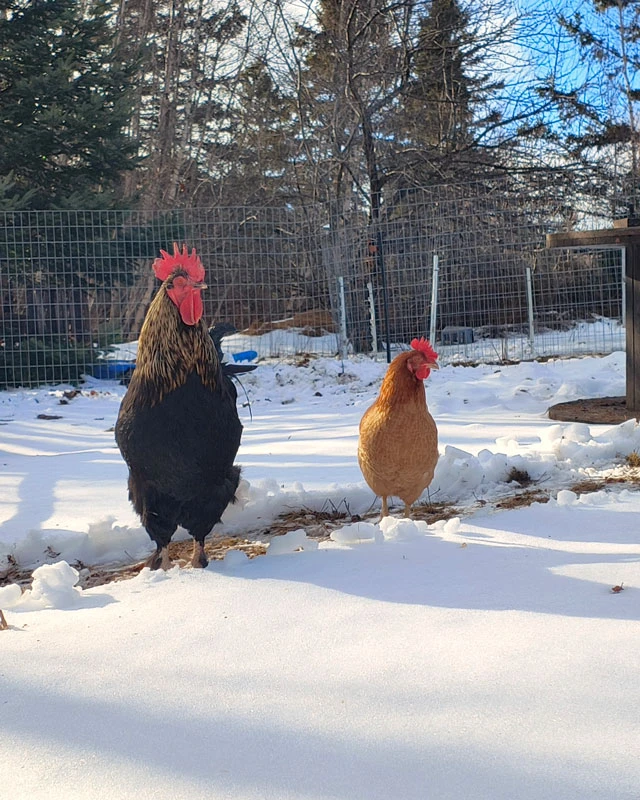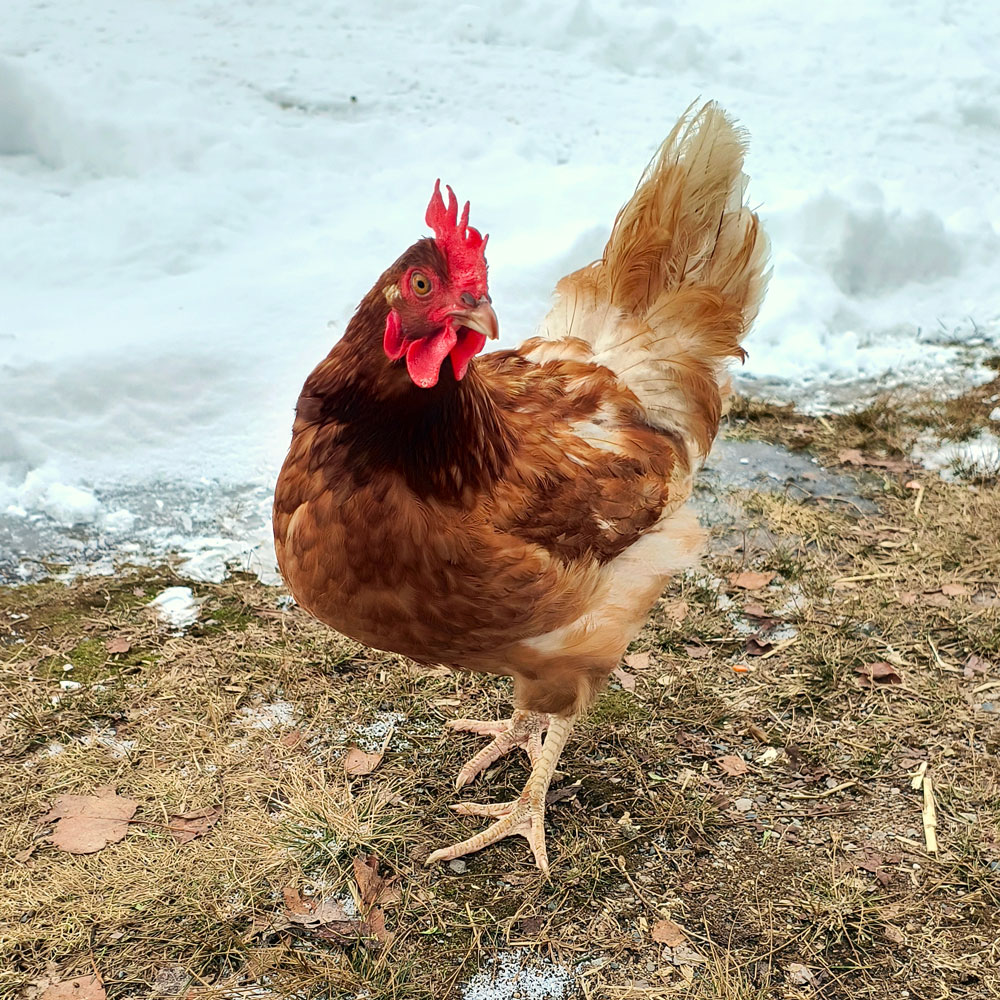Surviving (and Thriving) Through the Chill
A cozy guide to winter chicken keeping
You open the coop door one frosty morning and are greeted by a puff of warm air and a row of unimpressed chickens glaring at you like you’re the reason it’s cold outside. The water’s frozen solid and you’re wondering if your flock would like tiny parkas for Christmas.
We’ve all been there. Winter chicken keeping can feel like a balancing act between comfort, safety, and overcomplicating things. The truth is, your flock can handle cold weather far better than you think, they just need a little help staying dry, draft-free, and out of the wind. Here’s how to keep everyone happy until spring.
Your Top Priority: Keep Your Coop Dry and Draft-Free in Winter
Moisture is your real enemy in winter. Chickens can handle cold temperatures far better than damp air. That’s why good ventilation is so important, you need steady air exchange without creating drafts that blow directly on your birds. Frostbite can happen when combs and wattles are exposed to cold, moist air – not just low temperatures alone.
Make sure your coop has vents placed high up near the roofline. Warm, moist air naturally rises, so those upper vents give it a way to escape instead of condensing inside the coop. You still want protection from wind, so position the openings on the side facing away from prevailing winds. In my coops, I leave the eaves open on one side for airflow (the side away from prevailing winds) and close in the opposite side to keep the breeze off the birds.
To Heat or Not to Heat
This is one of those debates that never ends, and I’ll warn you now – opinions on this topic are strong. People tend to be firmly on “team heat” or “team no heat,” with very few sitting in the middle. Bring up heating your coop in a chicken group at your own risk and make sure you have thick skin if you happen to be brave enough to admit you use a heater! Things can get wild in a hurry.
My views on heat for chickens happen to fall somewhere in the middle of the extremes because, apparently, I’m an oddball. I believe that heat in a coop can have its place. Is is always, necessary? No. Sometimes it is, though, and we all have to do what works for our situation and what makes us feel good about caring for our birds. If we don’t agree on heat, that’s okay – you do what works for you, and I won’t try to change your mind.
Healthy, fully feathered chickens can tolerate surprising cold, even well below freezing. What they can’t handle are sudden temperature swings, dampness, or drafts. If you have a chicken that isn’t healthy, is missing a lot of feathers, or your coop is simply too large for the number of birds living in it, then a little heat might be worth considering.
For example, I actually do heat one of my coops because the rooster that lives there, Lucky, is especially prone to frostbite. You can read about poor Lucky’s frostbite woes here. We use a combination of a panel heater during the day and a low-wattage ceramic heat emitter bulb in a heat lamp base at night. The heat bulb is hung directly over Lucky’s roost to keep his comb warm at night without heating the coop itself. Ceramic heat emitter bulbs don’t produce light, so they don’t disturb sleep or natural rhythms – I use these in my brooders too. Yes, there is a fire risk with any heat source, but I take it seriously. The heat bulb housing is secured three different ways to make sure it won’t fall, I check each day to make sure the bulb is screwed in tightly, and there’s a smoke detector in the coop that sounds in our house 24/7. I also dust the bulb and housing off every day because dust is fuel.
If you don’t have any special cases like Mr. Lucky in your flock, they will probably make out just fine without heat.
If you do decide to use supplemental heat, it’s worth mentioning the biggest argument you’ll hear against it (besides the fire risk): if the power goes out during a deep freeze, your birds won’t be acclimated and could freeze to death. That can absolutely happen in climates where it stays super cold. Here, in Nova Scotia, it’s rare for winter temperatures to drop to dangerous extremes and, when they do, it usually isn’t for more than a couple of days. Since it’s a rare thing for us here I’d argue that none of our birds here are truly acclimated to that kind of cold anyway, heat or no heat.
If you choose to provide a bit of warmth, aim to keep the coop just above freezing and not toasty warm. Give your flock the choice to go outside daily (assuming it’s not a blizzard out there) so they stay adjusted to the winter air, and have a backup plan in place to keep the heat on in case the power goes out.
Control Humidity and Prevent Frostbite
Humidity is naturally high in our coastal climate, so it’s especially important to minimize any extra moisture inside the coop.
Poop equals moisture, and moisture equals humidity. Cleaning your coop daily goes a long way toward keeping the air dry and preventing frostbite. Even a quick scoop under the roost each morning makes a big difference. A clean, dry coop stays warmer, smells better, and keeps your birds happier all winter long. I know some folks like to do deep bedding and, if that’s you, well – you do you. I heap loads of fluffy bedding into my coops for insulation over the winter but I don’t leave the droppings in there all winter as the deep bedding method requires. I feel better when I remove all of the poop each morning. There is less smell (actually, there’s no smell), it’s cleaner, and there is less moisture. That’s just my preference.
Water inside the coop can also add unwanted humidity. If your flock refuses to come outside as some of mine does, you may need to compromise and let them have water indoors – just be sure to dump it outside before locking up for the night. Chickens don’t drink overnight anyway. If your birds are willing to venture out, keeping their water in the run is usually the best option. That said, I still keep a small waterer in my coops during the day, just in case someone isn’t feeling brave enough to face the cold.


Wrap the Run
A windchill is no joke. Wrapping your run with 6 mil poly vapor barrier can make a huge difference in keeping the wind and snow off your chickens. It’s not about sealing them in tight, it’s about creating a sheltered area where they can still get fresh air without being blasted by icy wind.
I use this product from Kent. It comes in different length and width rolls and you may not need the largest roll like I do so you can search their site for “6 mil vapor barrier” to see the other size rolls.
I use a hand stapler to hold the plastic sheeting in place until I can secure it with wooden strips. Using wood strips to secure the plastic helps spread the tension across a wider area, taking the pressure off the spots where the screws or staples go through. It’s a simple trick that keeps everything tight and secure all winter long.
I attach the wooden strips with screws but a brad nailer loaded with staples does the job well also. If my nailer didn’t keep freezing up while I worked I’d absolutely use it over screws.
Create Snow-Free Spaces
Even the hardiest chickens don’t love standing in snow all day. For warmer feet, provide areas where they can stay off of the snow. Throw down some hay or straw, or give them raised spots to perch on (an old pallet works great). Shoveling pathways for them helps a lot too.

Winter Feeding: Fuel for Feathered Furnaces
Cold weather burns calories – a lot of them! Chickens use extra energy just to stay warm, so they’ll naturally eat more in winter. The goal is to keep those little furnaces stoked without overdoing the extras.
I keep feed available free-choice all day long so everyone can eat as much as they want, whenever they want. Chickens do a good job of regulating their own intake, and I feel it’s better for them to snack throughout the day than to fill up at once.
Lots of people swear by giving cracked corn before bed to help keep their chickens warm overnight, but the jury’s still out on whether it actually makes a difference. It certainly doesn’t hurt, though! I like to give my flock a mix of scratch grains (barley, wheat, cracked corn) and black oil sunflower seeds each evening as a treat. If it helps keep them warm, great – if not, at least it gives them a fun little treasure hunt before bedtime.
Make sure feed stays dry, too. Wet or frozen feed is unappetizing (and basically chicken cement once it freezes). If you feed outside, a covered area or simple rain shelter works wonders. Inside the coop, hang your feeder high enough to keep bedding out for your sanity.
Fresh water is just as important as feed. Chickens won’t eat much if they can’t drink, and frozen waterers are a daily battle in winter. Heated water bases are worth their weight in gold if you can swing one. Otherwise, plan on swapping out water a few times a day. With the number of coops I have, I actually prefer to use rubber feed pans for water in winter even though all of the coops have power and could support heated waterers. On the coldest days they usually need refilling midday, but often they’ll go all day without freezing. If they do ice over, you can give the pan a good stomp to pop the ice out in one solid block without damaging the dish.
And of course, don’t forget the fun stuff: a handful of mealworms, warm oatmeal or a veggie scrap or two can lift everyone’s spirits on long, chilly days.
Lighting Considerations: Let Your Hens Rest
I don’t recommend using supplemental light at all. Your hens deserve a break from laying over the winter months, it’s their natural rest period. The energy they’d normally put into egg production is better spent staying warm and healthy through the cold season.
If you do decide to add light, though, make sure to turn it on before dawn instead of keeping it on late into the evening. That way, your chickens can still go to roost naturally at dusk. If they’re still on the ground when the lights suddenly shut off in the evening, they won’t be able to find their way to the roost – and nobody likes sleeping on the floor (except maybe Silkies).
Two of my coops don’t have windows to let in natural light so, in those two coops only, I use a low-wattage LED light during the daytime. It just helps the hens see what they’re doing when they go inside for a snack. This isn’t the same as using supplemental light to keep them laying; it’s simply to make up for the lack of a window so they can go about their day like normal.
Surviving vs. Thriving
Winter chicken keeping doesn’t have to be complicated. Keep the coop clean, dry, and draft-free, give your flock a wind-sheltered spot outside, and resist the urge to overdo the heat or light. If you do these things, your birds should handle the season just fine, and come spring, they’ll be rested, healthy, and ready to start laying again.
Sure, someone will always chime in to say they do none of these things and their chickens have survived just fine – and honestly, they probably have. But surviving and thriving are two very different things. I’d rather give my flock a little extra care so they spend winter cozy, content, and only mildly offended by the weather. In the end, trust your gut and do what makes sense for your setup – no matter what anyone else (including me) claims works for theirs.
Now grab a mug of something warm, take a deep breath, and remember – your chickens come with built-in down jackets. They’ve got this.


About the Author
Hey! I’m Krystal - one of those quirky, super-introverted types in real danger of becoming a hermit. You know the kind. I usually leave the mountain once a week for provisions, load up on chicken feed, shavings, groceries, and whatever lumber I’ve convinced myself I need, then hurry back home where it’s quiet and a lot less people-y.
Turning our little property into a thriving homestead has become my passion (and maybe my obsession). If you happen to stop by, you’ll almost always find me outside doing something - building a new coop in the chicken village, tackling a half-finished project, tending the garden, doing chicken chores, or wrangling birds. On the rare chance you catch me indoors, I’m probably in the kitchen or knee-deep in sketches and plans for whatever I’ve decided to do next.
If you like what you see here, come hang out with me on Facebook and Instagram for more homestead stories, flock updates, and a good dose of cozy chaos.
Thanks for stopping by!